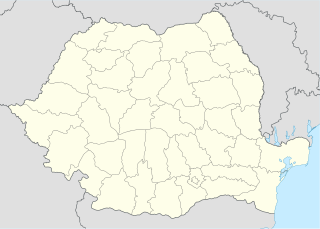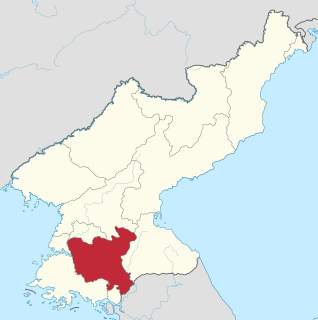The Cavnic mine is a large mine located in the northwest of Romania in Maramureş County, 26 km southwest of Baia Mare and 576 km north of the capital, Bucharest. Cavnic represents one of the largest polymetallic reserves in Romania having significant reserves of gold, silver, copper, lead and zinc amounting to 20 million tonnes of ore grading 1g/t gold, 30g/t silver, 2% lead, 3% zinc and 1% copper. The resources amount to 640,000 oz of gold, 19.2 million oz of silver, 400,000 tonnes of lead metal, 600,000 tonnes of zinc metal and 200,000 tonnes of copper metal.
The Muncelu Mic mine was a large open pit mine in the western of Romania in Hunedoara County, 16 km southeast of Simeria and 387 km north-west of the capital, Bucharest. Muncelu Mic represents one of the largest iron ore reserves in Romania having estimated reserves of 6.5 million tonnes of ore. When it was operational it produced around 200,000 tonnes of iron ore/year. The mine also has a gold and silver reserves of around 5.4 million tonnes grading 1g/t gold and 8g/t silver resulting 173,000 oz of gold and 1.38 million oz of silver.

The Cireșata mine is a large open pit mine in the west of Romania in Hunedoara County, 30 km north of Deva and 400 km north of the capital, Bucharest. Cireșata represents a large gold and copper deposit with estimated reserves of 4.18 million oz of gold and 174.4 million tonnes of copper ore grading 0.15% copper. The project is owned by the Toronto-based company Carpathian Gold.

The Vlahna mine is a large mine located in northern Albania in Kukës County, 256 kilometres (159 mi) north-east of the capital, Tirana. Vlahna represents the second largest chromium reserve in Albania and one of the largest in Europe having estimated reserves of 2.56 million tonnes of ore grading 29.2% chromium metal. The mine is part of the Tropojë Massif, a 440 square kilometres (170 sq mi) area which has a rock thickness between 6 kilometres (3.7 mi) and 8 kilometres (5.0 mi) and contains 286 verified chromium deposits and occurrences. The deposit has been explored to depths of up to 300 metres (980 ft) and the geological reserves amount to 6.1 million tonnes grading 26.48% chromium metal.

The Kalimashi 1 mine is a large mine located near the village Kalimash in northern Albania in Kukës County, 80 kilometres (50 mi) north-east of the capital, Tirana. Kalimashi 1 represents the fourth largest chromium reserve in Albania and one of the largest in Europe having estimated reserves of 1.9 million tonnes of ore grading 20% chromium metal. The mine is part of the Kukës Massif, a 108 square kilometres (42 sq mi) area which has a rock thickness between 4 kilometres (2.5 mi) and 6 kilometres (3.7 mi) and contains 54 verified chromium deposits and occurrences. The deposit has been explored to depths of up to 300 metres (980 ft) and the geological reserves amount to 6.8 million tonnes grading 21.4% chromium metal.

The Kalimashi 3 mine is a large mine located near the village Kalimash in northern Albania in Kukës County, 80 kilometres (50 mi) north-east of the capital, Tirana. Kalimashi 3 represents the fifth largest chromium reserve in Albania and one of the largest in Europe having estimated reserves of 1.6 million tonnes of ore grading 20% chromium metal. The mine is part of the Kukës Massif, a 108 square kilometres (42 sq mi) area which has a rock thickness between 4 kilometres (2.5 mi) and 6 kilometres (3.7 mi) and contains 54 verified chromium deposits and occurrences. The deposit has been explored to depths of up to 300 metres (980 ft) and the geological reserves amount to 6.8 million tonnes grading 21.4% chromium metal.

The Zogaj mine is a large mine located near the village Zogaj in northern Albania in Kukës County, 256 kilometres (159 mi) north-east of the capital, Tirana. Zogaj represents one of the largest chromium reserve in Albania and one of the largest in Europe having estimated reserves of 1.238 million tonnes of ore grading between 24 and 28% chromium metal. The mine is part of the Tropojë Massif, a 440 square kilometres (170 sq mi) area which has a rock thickness between 6 kilometres (3.7 mi) and 8 kilometres (5.0 mi) and contains 286 verified chromium deposits and occurrences. The deposit has been explored to depths of up to 300 metres (980 ft) and the geological reserves amount to 6.1 million tonnes grading 26.48% chromium metal.

The Përroi Batrës mine is a large mine located near the village Kalimash in northern Albania in Kukës County, 80 kilometres (50 mi) north-east of the capital, Tirana. Përroi Batrës represents one of the largest chromium reserve in Albania and one of the largest in Europe having estimated reserves of 1.2 million tonnes of ore grading 20% chromium metal. The mine is part of the Kukës Massif, a 108 square kilometres (42 sq mi) area which has a rock thickness between 4 kilometres (2.5 mi) and 6 kilometres (3.7 mi) and contains 54 verified chromium deposits and occurrences. The deposit has been explored to depths of up to 300 metres (980 ft) and the geological reserves amount to 6.8 million tonnes grading 21.4% chromium metal.

The Qaf-Perollaj mine is a large mine located near the village Zogaj in northern Albania in Kukës County, 256 kilometres (159 mi) north-east of the capital, Tirana. Qaf-Perollaj represents one of the largest chromium reserve in Albania and one of the largest in Europe having estimated reserves of 0.433 million tonnes of ore grading between 30 and 34% chromium metal. The mine is part of the Tropojë Massif, a 440 square kilometres (170 sq mi) area which has a rock thickness between 6 kilometres (3.7 mi) and 8 kilometres (5.0 mi) and contains 286 verified chromium deposits and occurrences. The deposit has been explored to depths of up to 300 metres (980 ft) and the geological reserves amount to 6.1 million tonnes grading 26.48% chromium metal.

The Săcărâmb mine is a large open pit mine in the west of Romania in Hunedoara County, 30 km north of Deva and 400 km north of the capital, Bucharest. Săcărâmb represents a large gold deposit with estimated reserves of 0.53 million oz of gold. The mine also has the only tellurium and selenium reserves in Romania having around 10 million tonnes grading 0.24g/tonnes for both elements. The project is owned by the Toronto-based company Carpathian Gold in association with the Romanian company Deva Gold.
Mining in North Korea is important to the country's economy. North Korea is naturally abundant in metals such as magnesite, zinc, tungsten, and iron; with magnesite resources of 6 billion tonnes, particularly in the Hamgyeong-do and Jagang-do provinces. However, often these cannot be mined due to the acute shortage of electricity in the country, as well as the lack of proper tools to mine these materials and an antiquated industrial base. Coal, iron ore, limestone, and magnesite deposits are larger than other mineral commodities. Mining joint ventures with other countries include China, Canada, Egypt, and South Korea.
The Ozyorny mine is one of the largest lead and zinc mines in Russia. The mine is located in south-eastern Russia in Buryatia. The mine has reserves amounting to 157 million tonnes of ore grading 1% lead and 5.2% zinc thus resulting 1.57 million tonnes of lead and 8.16 million tonnes of zinc. The mine also has reserves amounting to 800,000 oz of gold and 144 million oz of silver.
The Sangnong mine is one of the largest gold mines in North Korea and in the world. The mine is located in the center of the country in South Hamgyong Province. The mine has estimated reserves of 6.4 million oz of gold. The mine also has reserves amounting to 200 million tonnes of ore grading 0.23% copper metal.
The Hyesan mine is one of the largest silver mines in North Korea and in the world. The mine is located in the north of the country in Ryanggang Province. The mine has estimated reserves of 3.07 million oz of gold and 921.6 million oz of silver. The mine also has reserves amounting to 160 million tonnes of ore grading 0.35% copper, 3.2% lead and 3.6% zinc.
The Konttijärvi mine is one of the largest gold mines in Finland and in the world. The mine is located in the north of the country in Lapland. The mine has estimated reserves of 2.8 million oz of gold, 2.07 million oz of palladium and 0.58 million oz of platinum. The mine also has ore reserves amounting to 35.6 million tonnes grading 0.19% copper and 0.07% nickel.
The Ahmavaara mine is one of the largest gold mines in Finland and in the world. The mine is located in the north of the country in Lapland. The mine has estimated reserves of 4.5 million oz of gold, 3.4 million oz of palladium and 0.72 million oz of platinum. The mine also has ore reserves amounting to 78.1 million tonnes grading 0.24% copper and 0.09% nickel.
The Portimo mine is one of the largest gold mines in Finland and in the world. The mine is located in the north of the country in Lapland. The mine has estimated reserves of 4.9 million oz of gold, 3.73 million oz of palladium and 1 million oz of platinum. The mine also has ore reserves amounting to 78.1 million tonnes grading 0.10% copper and 0.07% nickel.
The Aganozersky mine is a large mine in the north of Russia in the Republic of Karelia. Aganozersky represents one of the largest nickel reserve in Russia having estimated reserves of 405 million tonnes of ore grading 0.15% nickel, 2.33 million oz of platinum, 1.66 million oz of palladium and 0.43 million oz of gold. The 405 million tonnes of ore contains 0.6 million tonnes of nickel metal.
The Shalozersky mine is a large mine in the north of Russia in the Republic of Karelia. Shalozersky represents one of the largest nickel reserve in Russia having estimated reserves of 306.1 million tonnes of ore grading 0.14% nickel, 4.56 million oz of platinum, 3.91 million oz of palladium and 0.85 million oz of gold. The 306.1 million tonnes of ore contains 0.43 million tonnes of nickel metal.
The Maslovskoye mine is a large mine in the center of Russia in the Krasnoyarsk Krai. Maslovskoye represents one of the largest nickel reserve in Russia having estimated reserves of 215 million tonnes of ore grading 0.33% nickel, 12.5 million oz of platinum, 35.5 million oz of palladium and 1.3 million oz of gold. The 215 million tonnes of ore contains 0.73 million tonnes of nickel metal.




